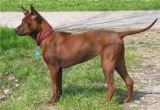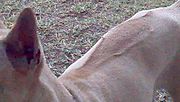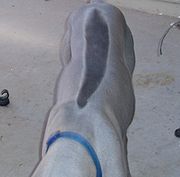
Thai Ridgeback
Encyclopedia
The Thai Ridgeback is an ancient breed
of dog
. The breed was formerly unknown outside of Thailand
, but is gaining notice in the Western world. The Thai Ridgeback is one of only three breeds that has a ridge of hair that runs along its back in the opposite direction to the rest of the coat (The others are Rhodesian Ridgeback
and Phu Quoc Ridgeback). They are also known as a Mah Thai Lang Ahn.
-type dog with a wedge-shaped head, triangular-shaped prick ears, and a very short, smooth coat. It has a pronounced ridge on its back formed by hair growing in the opposite direction that extends from behind the withers to the hips. Puppies are occasionally born ridgeless. Thai Ridgebacks have a muscular and streamlined body, making them extremely agile. The tail is carried upward called a sickle or sword tail. Its forehead wrinkles with enormous expression. Like many eastern breeds, the Thai Ridgeback has retained a 'scissor jaw' where upper and lower teeth interlock when the jaw bones clamp down. The tongue can be black or have black marks. Eyes are almond-shaped and brown but may be amber in blue dogs. The ears are set low and point slightly outward. The ears stand up progressively during the puppy growth period, they are not cropped. The back is straight and level. The coat is short, hard, and straight. Due to the length and density of the coat shedding is minimal, occurring once or twice yearly. Because this breed does not have an undercoat the hair does not usually bother people allergic to other breeds of dogs. Coat must be solid colors of blue, black, red or fawn with a black mask
being acceptable on reds. However, brindle
and white are also found but are not acceptable colors. For international show and competition, shoulder height should be 22-24 inches (56-61 cm) in males and 20-22 inches (51-56 cm) in females. The weight averages 35–55lbs in females and 40-60lbs in males.
Eight distinctive ridge patterns have been identified: needle, feather, arrow, lute, violin, bowling pin, leaf, and saddleback. All patterns are acceptable, but must be clearly defined and symmetrical. The broader the ridge, the more highly it is prized.
. Modern lines of Thai Ridgeback, resulting from interpopulation crosses, may also be prone to hip dysplasia and other genetic disorders.
 Thai Ridgebacks are an intelligent breed. The energy level is typically medium to high, with most of the day spent lounging and activity periods occurring in sporadic bursts. Well bred and properly socialized Thai Ridgebacks make loyal, loving family pets. They are naturally protective of their home and family and can be aggressive or shy when not properly socialized. They are best kept by consistent owners who have a thorough understanding of dog behavior. Because of prior geographic isolation and lack of human contact, the Thai Ridgeback remains independent minded and much of the original natural instinct and drives remain intact, particularly prey drive. Due to its nature, the Thai Ridgeback is not recommended for the novice dog handler. They have an excellent jumping ability and may seek to roam if not properly contained.
Thai Ridgebacks are an intelligent breed. The energy level is typically medium to high, with most of the day spent lounging and activity periods occurring in sporadic bursts. Well bred and properly socialized Thai Ridgebacks make loyal, loving family pets. They are naturally protective of their home and family and can be aggressive or shy when not properly socialized. They are best kept by consistent owners who have a thorough understanding of dog behavior. Because of prior geographic isolation and lack of human contact, the Thai Ridgeback remains independent minded and much of the original natural instinct and drives remain intact, particularly prey drive. Due to its nature, the Thai Ridgeback is not recommended for the novice dog handler. They have an excellent jumping ability and may seek to roam if not properly contained.

 The ridgeback is under a control of two groups of epistatic genes. The first determines the existence of the ridge. The other determines the size of the ridge, from none to very large (down to the side). For the latter, the more the genes in the dog, the broader is the ridge. The ridge will appear only if there is at least one dominant allele in both groups.
The ridgeback is under a control of two groups of epistatic genes. The first determines the existence of the ridge. The other determines the size of the ridge, from none to very large (down to the side). For the latter, the more the genes in the dog, the broader is the ridge. The ridge will appear only if there is at least one dominant allele in both groups.
The third existing breed of ridgeback dogs is the Phu Quoc Ridgeback of Vietnam
, which is somewhat smaller than the Thai Ridgeback. Based on genetic-based hypothesis, both Thai Ridgeback Dog and Phu Quoc Dog are likely to be descended from Funan Ridgeback Dog which originated over 1,000 years ago in Funan Era of the region. The Hottentot Dog or Ari Dog (as called by the tribe), a known African ridgeback ancestor of the Rhodesian Ridgeback, is now extinct. Its link to the Funan Ridgeback Dog is very likely in a historian opinion. The possible genetic connection among the three remaining breeds is being investigated through DNA studies.
The relationship between the Thai Ridgeback and the Rhodesian Ridgeback
is uncertain, but possible through the Hottentot Dog or Ari Dog. There is minimal scientific proof that they are related.
Breed
A breed is a group of domestic animals or plants with a homogeneous appearance, behavior, and other characteristics that distinguish it from other animals or plants of the same species. Despite the centrality of the idea of "breeds" to animal husbandry, there is no scientifically accepted...
of dog
Dog
The domestic dog is a domesticated form of the gray wolf, a member of the Canidae family of the order Carnivora. The term is used for both feral and pet varieties. The dog may have been the first animal to be domesticated, and has been the most widely kept working, hunting, and companion animal in...
. The breed was formerly unknown outside of Thailand
Thailand
Thailand , officially the Kingdom of Thailand , formerly known as Siam , is a country located at the centre of the Indochina peninsula and Southeast Asia. It is bordered to the north by Burma and Laos, to the east by Laos and Cambodia, to the south by the Gulf of Thailand and Malaysia, and to the...
, but is gaining notice in the Western world. The Thai Ridgeback is one of only three breeds that has a ridge of hair that runs along its back in the opposite direction to the rest of the coat (The others are Rhodesian Ridgeback
Rhodesian Ridgeback
The Rhodesian Ridgeback is a dog breed developed in Southern Africa, where it was used to hunt Lions. This is most likely why this dog is known for its bravery...
and Phu Quoc Ridgeback). They are also known as a Mah Thai Lang Ahn.
Appearance and Structure
The Thai Ridgeback is a muscular, medium-sized pariahPariah dog
The term pariah dog originally referred to Chinese/Indian feral dogs of a particular type, but it is now used by the United Kennel Club to refer to a purebred dog category.- Feral dogs of India :...
-type dog with a wedge-shaped head, triangular-shaped prick ears, and a very short, smooth coat. It has a pronounced ridge on its back formed by hair growing in the opposite direction that extends from behind the withers to the hips. Puppies are occasionally born ridgeless. Thai Ridgebacks have a muscular and streamlined body, making them extremely agile. The tail is carried upward called a sickle or sword tail. Its forehead wrinkles with enormous expression. Like many eastern breeds, the Thai Ridgeback has retained a 'scissor jaw' where upper and lower teeth interlock when the jaw bones clamp down. The tongue can be black or have black marks. Eyes are almond-shaped and brown but may be amber in blue dogs. The ears are set low and point slightly outward. The ears stand up progressively during the puppy growth period, they are not cropped. The back is straight and level. The coat is short, hard, and straight. Due to the length and density of the coat shedding is minimal, occurring once or twice yearly. Because this breed does not have an undercoat the hair does not usually bother people allergic to other breeds of dogs. Coat must be solid colors of blue, black, red or fawn with a black mask
Melanistic mask
A melanistic mask is a dog coat pattern that gives the appearance of a mask on the dog's face. The hairs on the muzzle, and sometimes entire face or ears, are colored by eumelanin instead of pheomelanin pigment. Eumelanin is typically black, but may instead be brown, dark gray, or light gray-brown...
being acceptable on reds. However, brindle
Brindle
Brindle is a coat coloring pattern in animals, particularly dogs, cats, cattle, guinea pigs, crested geckos and, rarely, horses. It is sometimes described as "tiger striped", although the brindle pattern is more subtle than that of a tiger's coat...
and white are also found but are not acceptable colors. For international show and competition, shoulder height should be 22-24 inches (56-61 cm) in males and 20-22 inches (51-56 cm) in females. The weight averages 35–55lbs in females and 40-60lbs in males.
Eight distinctive ridge patterns have been identified: needle, feather, arrow, lute, violin, bowling pin, leaf, and saddleback. All patterns are acceptable, but must be clearly defined and symmetrical. The broader the ridge, the more highly it is prized.
Health
Thai ridgebacks are a hardy, overall healthy breed with few inherent heath issues. The breed has reproduced in Thailand almost exclusively by natural selection until the very recent past. The domesticated population is small. Inbreeding depression has not been observed in the breed. Thai Ridgeback Dogs are prone to dermoid sinusDermoid sinus
Dermoid sinus is a genetic, autosomal skin condition in dogs. It is also known as pilonidal sinus because it resembles pilonidal sinus in humans. However, unlike pilonidal sinus in humans, dermoid sinus in dogs is a neural tube defect. Dermoid sinus is sometimes also confused with dermoid cyst...
. Modern lines of Thai Ridgeback, resulting from interpopulation crosses, may also be prone to hip dysplasia and other genetic disorders.
Temperament

Ridge


Color
Coat color is also under a control of two groups of epistatic genes. The first determines the color of the coat if it should be black, brindle, red or white. The series of dominance is black to brindle to red to white. The intensity of the coat color is under control of a set of modifying genes. The other group controls the dilution of the colors. Black can be dilute to gray/silver/blue, and red will turn fawn. The normal color is dominance over the diluted.History
The origin of the Thai Ridgeback is undocumented, but the breed was developed in eastern Thailand. The history of the breed is the subject of numerous hypotheses. It is generally considered a Pariah-type dating back to ancient times. The Thai Ridgeback may have mutated from another form of Thai dog which has similar appearance but with no ridge on the back. Rock art indicated that Thai dogs had accompanied a hunter since the new stone age of the country (over 2,000 years ago). Due to the isolation of Thai villages in the past, the breed had been inbred within the village for centuries. As a result, the appearance of the breed is quite uniform. Most lethal traits had been discarded through several generations of natural selection. The breed has a low level of inbreeding depression.The third existing breed of ridgeback dogs is the Phu Quoc Ridgeback of Vietnam
Vietnam
Vietnam – sometimes spelled Viet Nam , officially the Socialist Republic of Vietnam – is the easternmost country on the Indochina Peninsula in Southeast Asia. It is bordered by China to the north, Laos to the northwest, Cambodia to the southwest, and the South China Sea –...
, which is somewhat smaller than the Thai Ridgeback. Based on genetic-based hypothesis, both Thai Ridgeback Dog and Phu Quoc Dog are likely to be descended from Funan Ridgeback Dog which originated over 1,000 years ago in Funan Era of the region. The Hottentot Dog or Ari Dog (as called by the tribe), a known African ridgeback ancestor of the Rhodesian Ridgeback, is now extinct. Its link to the Funan Ridgeback Dog is very likely in a historian opinion. The possible genetic connection among the three remaining breeds is being investigated through DNA studies.
The relationship between the Thai Ridgeback and the Rhodesian Ridgeback
Rhodesian Ridgeback
The Rhodesian Ridgeback is a dog breed developed in Southern Africa, where it was used to hunt Lions. This is most likely why this dog is known for its bravery...
is uncertain, but possible through the Hottentot Dog or Ari Dog. There is minimal scientific proof that they are related.
See also
- Phu Quoc Ridgeback
- Rhodesian RidgebackRhodesian RidgebackThe Rhodesian Ridgeback is a dog breed developed in Southern Africa, where it was used to hunt Lions. This is most likely why this dog is known for its bravery...
- KombaiCombaiThe Combai is a bear hound found in the south of India. This breed of dog is slightly shorter than the Rajapalayam, but appears heavier because of its powerful build.-Appearance:The kombai is usually tan or red brown...
- note the Kombai is not a "ridged" dog in the same sense as the Thai, Phu Quoc and Rhodesian. - Canis lupus dingoCanis lupus dingoThe taxon Canis lupus dingo is named for its most famous and original member, the Australian Dingo, but it also includes non-Australian animals such as the New Guinea Singing Dog, the Thai Dog, and other animals which are considered taxonomically identical to the Australian Dingo. so any...

